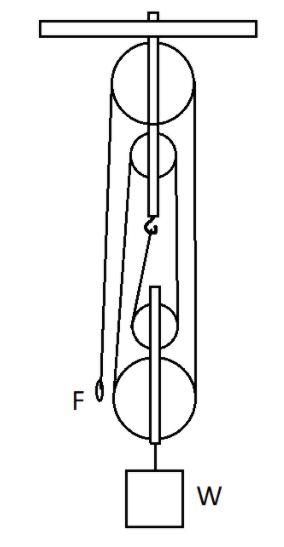
Answer
83.7k+ views
Hint: This could be simply solved by breaking the diagrams into simple free body diagrams of both the blocks. Then apply Newton’s law of motion.
Formula used: Here, we will use the basic formula NLM-2:
${\text{F = ma}}$
Here, ${\text{F}}$ is the force exerted on the block
${\text{m}}$ is the mass of the block
${\text{a}}$ is acceleration of the block
Complete step by step answer:
We already know that the bodies are connected together by rope,
So, both the bodies will have the same acceleration.
As we know that the movable part is known as tackle in which load is always attached and fixed part is known as block, but in this diagram the pulley on which load is applied is connected to tackle pulley hence by observing the configuration we can say four tackle is required for it to support the load.
Then we need to match the correct option.
The correct option is C.
Additional Information: A pulley is a wheel on an axle or shaft that is designed to support movement and change of direction of a taut cable or belt, or transfer of power between the shaft and cable or belt. In the case of a pulley supported by a frame or shell that does not transfer power to a shaft, but is used to guide the cable or exert a force, the supporting shell is called a block, and the pulley may be called a sheave
Note: It should be always kept in mind that we should always draw the FBD of the body before solving any force questions. Also, never forget to assume tension force away from the body wherever there is rope in pulley or block questions. Similarly, spring forces also are a case of springs acting tensile (away) from the body. Also, if the bodies are connected together, they will have the same acceleration.
Formula used: Here, we will use the basic formula NLM-2:
${\text{F = ma}}$
Here, ${\text{F}}$ is the force exerted on the block
${\text{m}}$ is the mass of the block
${\text{a}}$ is acceleration of the block
Complete step by step answer:
We already know that the bodies are connected together by rope,
So, both the bodies will have the same acceleration.
As we know that the movable part is known as tackle in which load is always attached and fixed part is known as block, but in this diagram the pulley on which load is applied is connected to tackle pulley hence by observing the configuration we can say four tackle is required for it to support the load.
Then we need to match the correct option.
The correct option is C.
Additional Information: A pulley is a wheel on an axle or shaft that is designed to support movement and change of direction of a taut cable or belt, or transfer of power between the shaft and cable or belt. In the case of a pulley supported by a frame or shell that does not transfer power to a shaft, but is used to guide the cable or exert a force, the supporting shell is called a block, and the pulley may be called a sheave
Note: It should be always kept in mind that we should always draw the FBD of the body before solving any force questions. Also, never forget to assume tension force away from the body wherever there is rope in pulley or block questions. Similarly, spring forces also are a case of springs acting tensile (away) from the body. Also, if the bodies are connected together, they will have the same acceleration.
Recently Updated Pages
Name the scale on which the destructive energy of an class 11 physics JEE_Main

Write an article on the need and importance of sports class 10 english JEE_Main

Choose the exact meaning of the given idiomphrase The class 9 english JEE_Main

Choose the one which best expresses the meaning of class 9 english JEE_Main

What does a hydrometer consist of A A cylindrical stem class 9 physics JEE_Main

A motorcyclist of mass m is to negotiate a curve of class 9 physics JEE_Main

Other Pages
The bond order of ClO bond in ClO4 ion and the effective class 11 chemistry JEE_Main

Derive an expression for maximum speed of a car on class 11 physics JEE_Main

Differentiate between homogeneous and heterogeneous class 12 chemistry JEE_Main

Electric field due to uniformly charged sphere class 12 physics JEE_Main

If a wire of resistance R is stretched to double of class 12 physics JEE_Main

Why does capacitor block DC and allow AC class 12 physics JEE_Main




